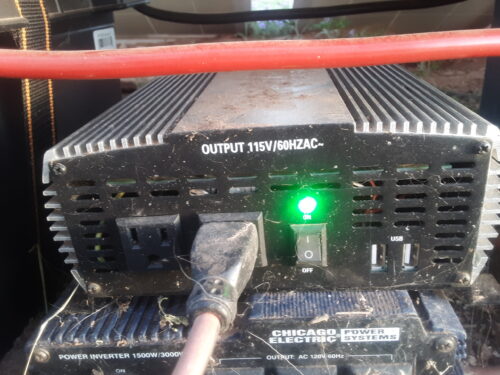
Hi there, K again. So, we’ve talked about solar panels, controllers and batteries. Let’s discuss the last part of the puzzle–how to convert the D.C. power from the batteries to something useful for your home. Introducing… the inverter.
The inverter transforms the D.C. power stored in the batteries, to household 110 volt A.C. electricity. When you go to buy an inverter, you will see 3 ratings on the case: the voltage of the inverter, the maximum amount of wattage it can produce, and whether it’s a pure sine wave or a modified sine wave inverter (see details below).
1. Voltage
The inverter must match the voltage of the battery bank. If you have a 12 volt battery bank, you must use a 12 volt inverter; if you have a 24 volt system, use a 24 volt inverter. If you put a 24 volt inverter on a 12 volt battery system, nothing will happen. If you put a 12 volt inverter on a 24 volt battery system, you’ll probably blow the inverter. That’s the kind of drama you don’t want!
2. Maximum wattage
Consider the wattage of the inverter. Again, match the wattage ratings to your actual needs. If you’re just looking to power some lights, use a small T.V. and maybe keep your cell phone charged, look for something in the range of 400 watts. When dealing with limited power, the bigger is better mentality is not useful and could be harmful. Higher wattage inverters use more stand-by power than small ones. As an example, we have a full size fridge, two T.V.s, washing machine, water pump, lights, food processors, evaporative coolers, computers, rechargeable tools, and flashlights. We need a 1200 watt inverter to run all of these appliances.
3. Sine wave
Is it a pure sine or a modified sine wave inverter? Before I get into this, I want the reader to be aware I’m not an electrician or an electrical engineer. I have not done in-depth studies in electricity. I can only tell you what I have experienced as a user in the last twenty years after trying out both of these types of inverters.
Battery power is classified as D.C. electricity–D.C. means direct current. Power flows from the positive terminal to the negative terminal and powers whatever is connected to it. Household power is classified as A.C. electricity. A.C. means alternating current–power flows from the positive terminal to the negative terminal, and then back to the positive, meaning it alternates. Typically, it alternates 60 times per minute, and is classified as 60 hertz power or… pure sine wave.
A modified sine wave alternates at 50 hertz, or 50 times a minute. The major question is, what practical difference is there in whether the electricity alternates at 50 or 60 hertz? The only thing I could tell is this: back in the ‘90s when people still used the old analog clocks, the second hand would move forward one second every time the power alternated. This meant that at pure sine wave, the clocks second hand would move 60 times per minute keeping perfect time; with modified sine wave, the second hand only moved forward 50 times per minute, losing 10 seconds per minute. The easy fix for me was to buy battery powered clocks. Everything else in the house worked perfectly with modified sine wave power.
Considering that pure sine wave inverters cost almost 3 times as much as a modified sine wave inverter, and that a modified sine wave alternated at 50 hertz meaning I was using 16% less power, for me the choice was obvious–I stuck with modified wave inverters.
So, in this series of blog posts, I’ve talked about the four main components of a photovoltaic system: solar panels, controllers, batteries, and inverters. Let’s briefly put it all together:
- The solar panels capture energy from the sun.
- The controller converts it so it can be stored in the batteries
- The batteries store the energy till you turn on an appliance.
- The inverter changes the energy from the battery into a form your appliances can use.
There are a lot of resources out there to get more details, but Parts 1 through 6 in this series of blog posts give you the basic information to put together a photovoltaic system.
Next blog post: Part 1: Dairy Farming–what is it and why do we care?
